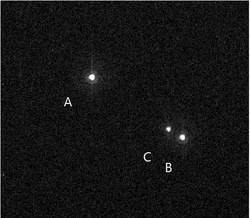LTT 1445
LTT 1445 is a triple M-dwarf system about 22 light-years distant[4] in the constellation Eridanus. The primary LTT 1445 A hosts one exoplanet that transits the star every five days. As of August 2019 it is the second closest transiting exoplanet system discovered, with the closest being HD 219134 bc.[4]
 Hubble ACS/HRC image showing all three stars. Upper left is LTT 1445 A and in the lower right part of the image is the LTT 1445 BC pair. | |
| Observation data Epoch J2000.0 Equinox J2000.0 | |
|---|---|
| Constellation | Eridanus |
| LTT 1445 A | |
| Right ascension | 03h 01m 51.39s[1] |
| Declination | −16° 35′ 36.1″[1] |
| Apparent magnitude (V) | 11.22 ± 0.02[1] |
| LTT 1445 BC | |
| Right ascension | 03h 01m 51.04s[1] |
| Declination | –16° 35′ 31.1″[1] |
| Apparent magnitude (V) | 11.37±0.03[1] |
| Characteristics | |
| Spectral type | M2.5+M3.0+M[2][1] |
| Astrometry | |
| LTT 1445 A | |
| Proper motion (μ) | RA: -369.196 ± 0.140[3] mas/yr Dec.: -268.510 ± 0.147[3] mas/yr |
| Parallax (π) | 145.5466 ± 0.0800[3] mas |
| Distance | 22.41 ± 0.01 ly (6.871 ± 0.004 pc) |
| Orbit[1] | |
| Primary | LTT 1445 B |
| Companion | LTT 1445 C |
| Period (P) | 36.2 ± 5.3 yr |
| Semi-major axis (a) | 1.159 ± 0.076″ |
| Eccentricity (e) | 0.50 ± 0.11 |
| Inclination (i) | 89.64 ± 0.13° |
| Longitude of the node (Ω) | 137.63 ± 0.19° |
| Periastron epoch (T) | 2019.2 ± 1.7 |
| Argument of periastron (ω) (secondary) | 209 ± 13° |
| Details | |
| Mass | A: 0.256 ± 0.014[1] M☉ B: 0.215 ± 0.014[1] M☉ C: 0.161 ± 0.014[1] M☉ |
| Radius | A: 0.276+0.024 −0.019[1] R☉ B: 0.236 ± 0.027[1] R☉ C: 0.197 ± 0.027[1] R☉ |
| Luminosity (bolometric) | A: 0.00805 ± 0.00035[1] L☉ |
| Surface gravity (log g) | A: 4.967+0.061 −0.075[1] cgs |
| Temperature | A: 3337 ± 150[1] K |
| Metallicity [Fe/H] | A: -0.34 ± 0.08[1] dex |
| Other designations | |
| Database references | |
| SIMBAD | A,BC |
Stellar system
All three stars in the system are M-dwarfs, with masses between 0.16 M☉ and 0.26 M☉. LTT 1445 A and LTT 1445 BC are separated by about 34 astronomical units and orbit each other with a period of about 250 years. The BC pair orbit each other about every 36 years in an eccentric orbit (e= ~0.5). The alignment of the three stars and the edge-on orbit of the BC pair is suggesting a co-planarity of the system. The existence of a transiting planet LTT 1445Ab suggests that the entire system is co-planar, with orbits in one plane.[1]
The TESS light curve showed stellar flares and rotational modulation due to starspots, likely on either the B or C component.[1][5]
Planetary system
LTT 1445Ab was discovered in August 2019 with data from the Transiting Exoplanet Survey Satellite by astrophysicists of the Harvard Center for Astrophysics.[4] The team obtained follow-up observations, including HARPS radial velocity measurements to constrain the mass of the planet. The planet orbits only one host star in a stable orbit. The planet likely has a rocky composition and because it orbits close to the M-dwarf, it has an equilibrium temperature of 433+28
−27 Kelvin (160 °C; 320 °F).[1]
| Companion (in order from star) |
Mass | Semimajor axis (AU) |
Orbital period (days) |
Eccentricity | Inclination | Radius |
|---|---|---|---|---|---|---|
| b | <8.4 M⊕ | 0.03807+0.00068 −0.00071 |
5.35882+0.00030 −0.00031 |
0.19+0.35 −0.14 |
89.40+0.41 −0.46° |
1.38+0.13 −0.12 R⊕ |
See also
- List of star systems within 20–25 light-years
- List of nearest exoplanets
- EZ Aquarii nearby M-dwarf triple
- GJ 1245 nearby M-dwarf triple[1]
- Gliese 667 Cc
References
- Winters, Jennifer G.; Medina, Amber A.; Irwin, Jonathan M.; Charbonneau, David; Astudillo-Defru, Nicola; Horch, Elliott P.; Eastman, Jason D.; Halley Vrijmoet, Eliot; Henry, Todd J.; Diamond-Lowe, Hannah; Winston, Elaine (October 2019). "Three Red Suns in the Sky: A Transiting, Terrestrial Planet in a Triple M-dwarf System at 6.9 pc". AJ. 158 (4): 152. Bibcode:2019AJ....158..152W. doi:10.3847/1538-3881/ab364d. hdl:2144/39814. ISSN 0004-6256.
- Henry, Todd J.; Jao, Wei-Chun; Winters, Jennifer G.; Dieterich, Sergio B.; Finch, Charlie T.; Ianna, Philip A.; Riedel, Adric R.; Silverstein, Michele L.; Subasavage, John P.; Vrijmoet, Eliot Halley (June 2018). "The Solar Neighborhood XLIV: RECONS Discoveries within 10 parsecs". AJ. 155 (6): 265. arXiv:1804.07377. Bibcode:2018AJ....155..265H. doi:10.3847/1538-3881/aac262. ISSN 0004-6256.
- Gaia Collaboration (2018-08-01). "Gaia Data Release 2 - Summary of the contents and survey properties". Astronomy & Astrophysics. 616: A1. arXiv:1804.09365. Bibcode:2018A&A...616A...1G. doi:10.1051/0004-6361/201833051. ISSN 0004-6361.
- Brennan, Pat. "Discovery Alert: Rocky Planet Swelters Under Three Red Suns". Exoplanet Exploration: Planets Beyond our Solar System. Retrieved 2020-02-13.
- Howard, Ward S.; Corbett, Hank; Law, Nicholas M.; Ratzloff, Jeffrey K.; Glazier, Amy; Fors, Octavi; del Ser, Daniel; Haislip, Joshua (August 2019). "EvryFlare. I. Long-term Evryscope Monitoring of Flares from the Cool Stars across Half the Southern Sky". Astrophysical Journal. 881 (1): 9. arXiv:1904.10421. Bibcode:2019ApJ...881....9H. doi:10.3847/1538-4357/ab2767. ISSN 0004-637X.